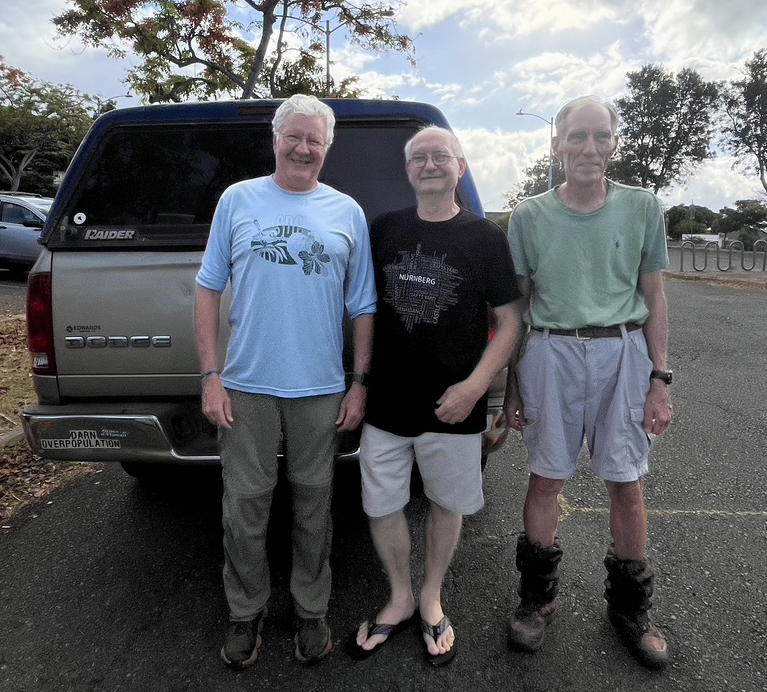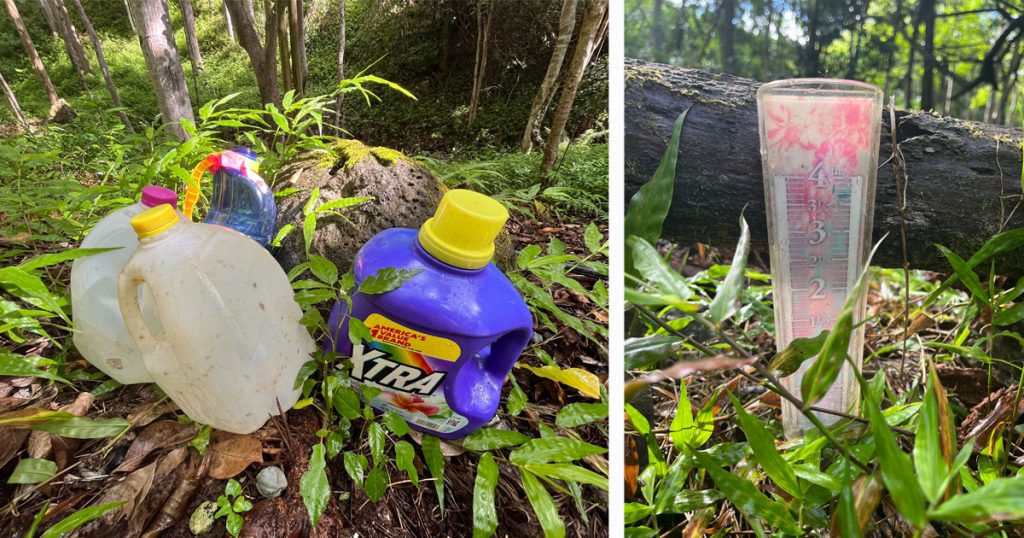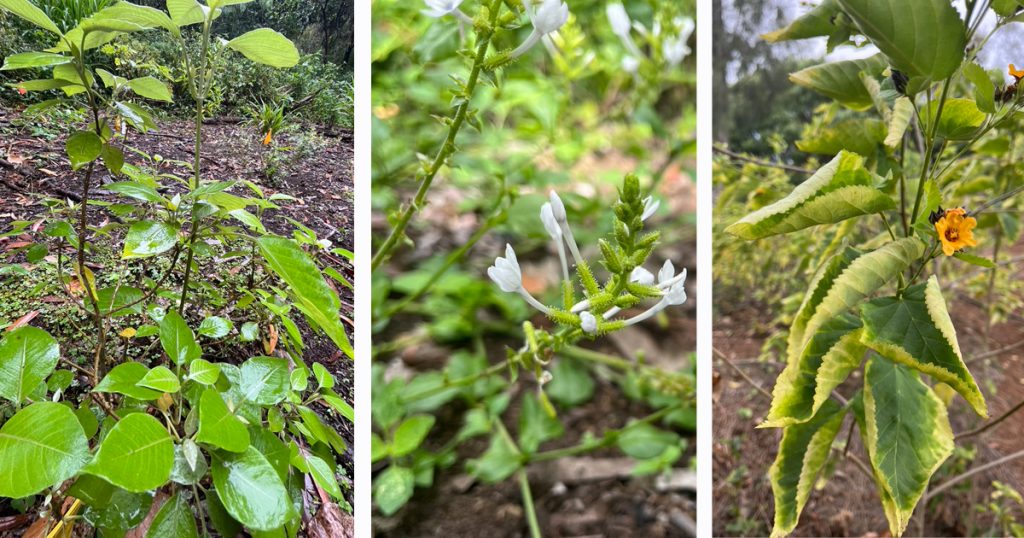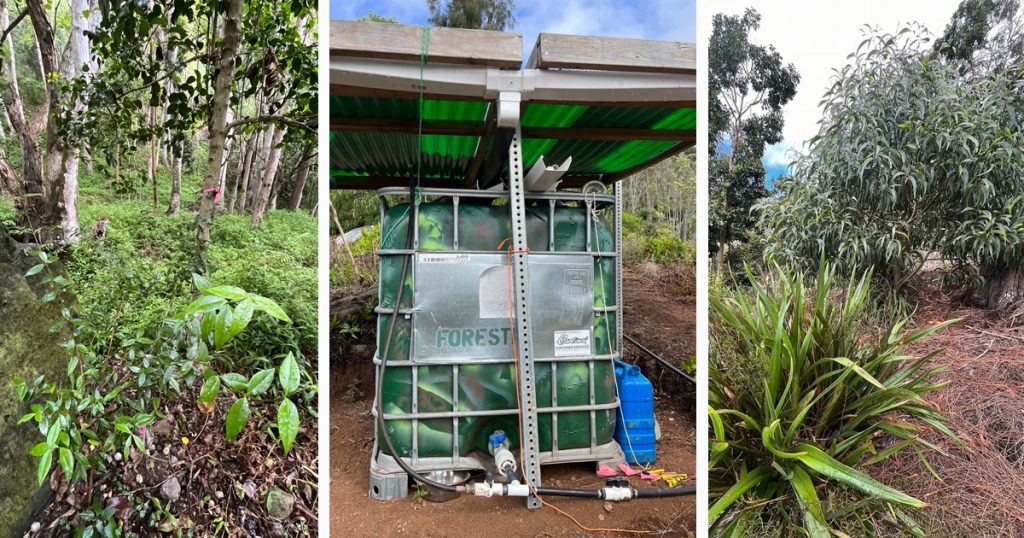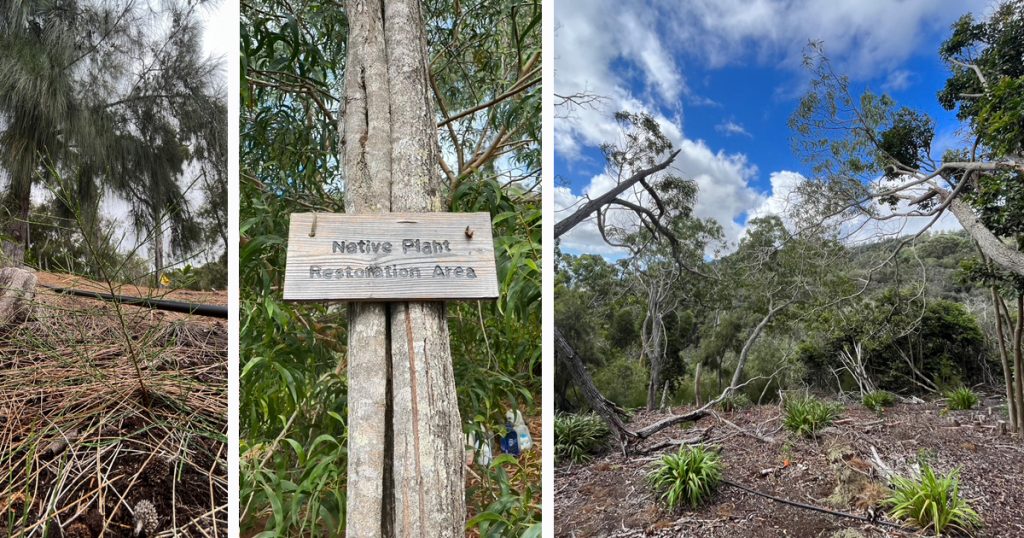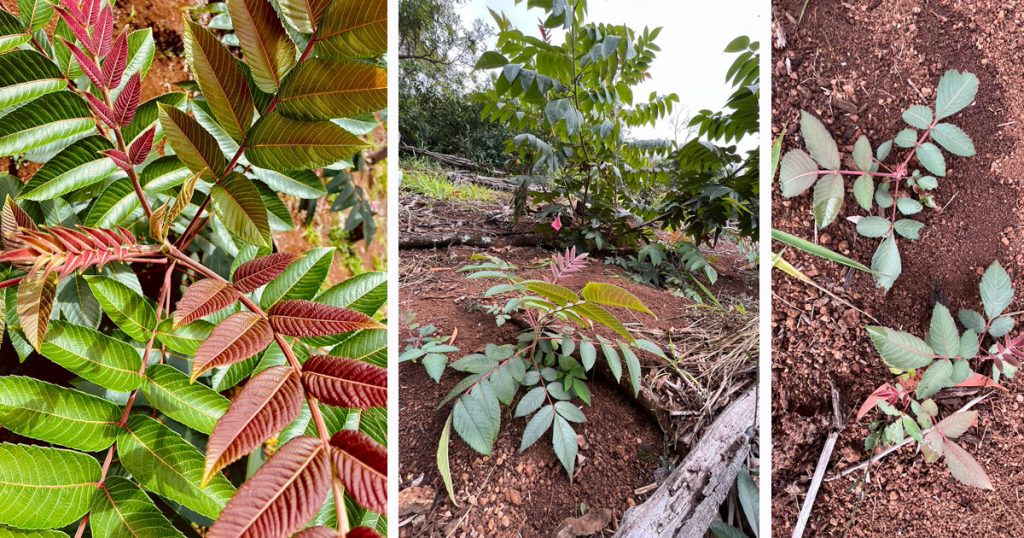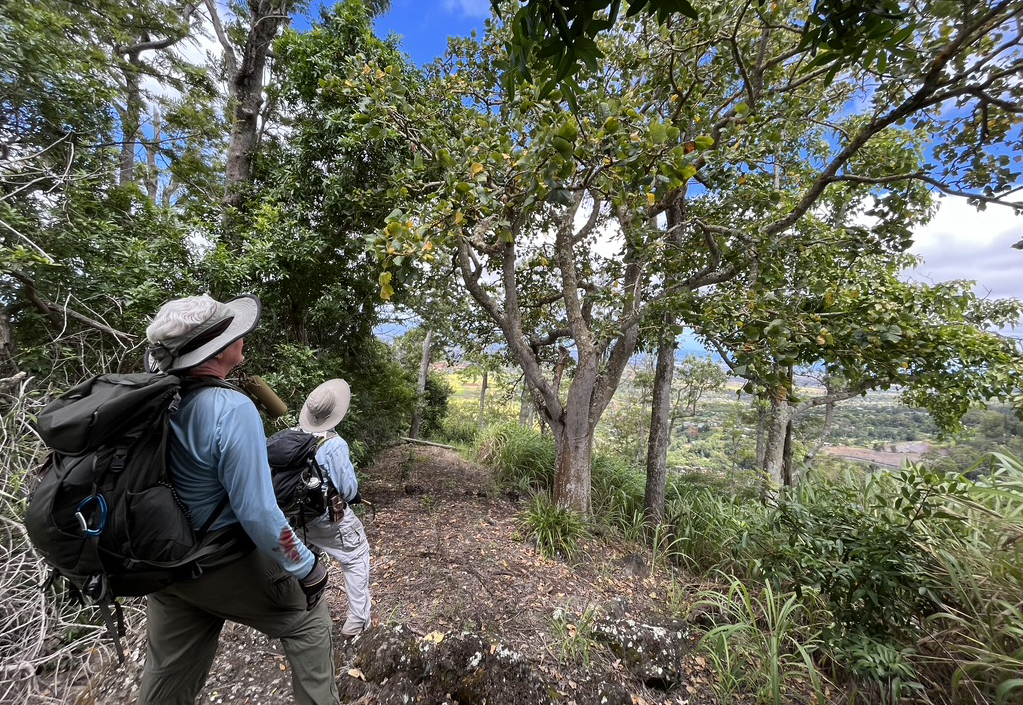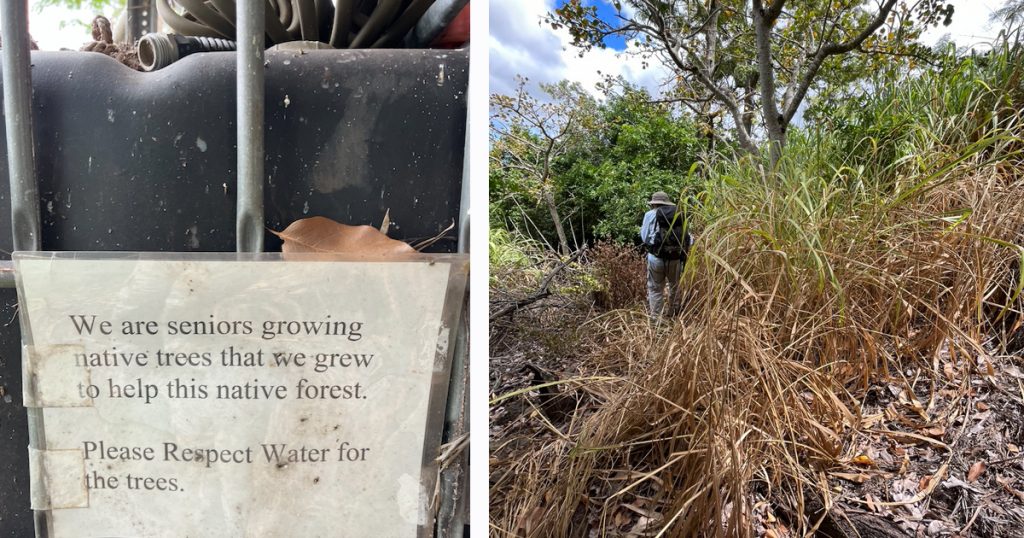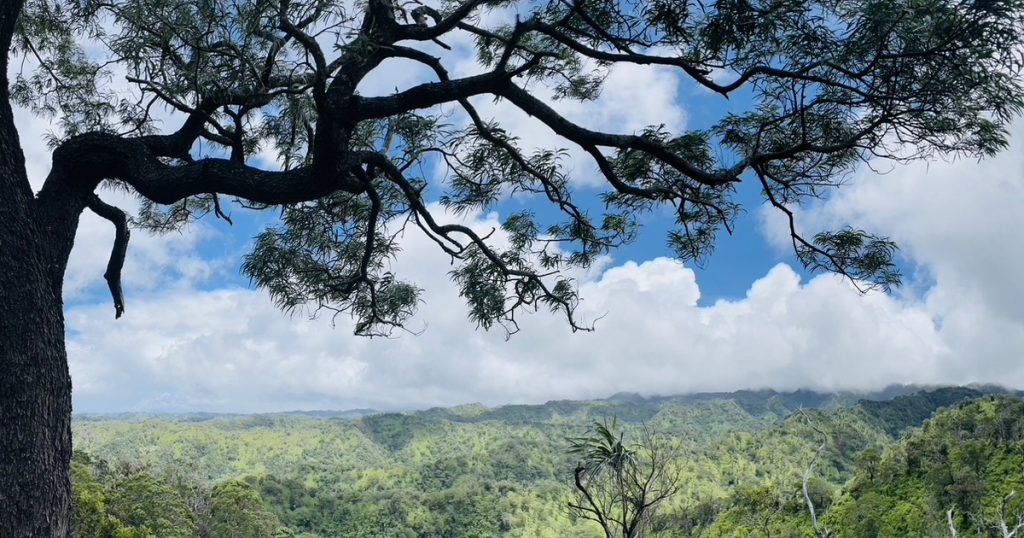Talk Story with SDC
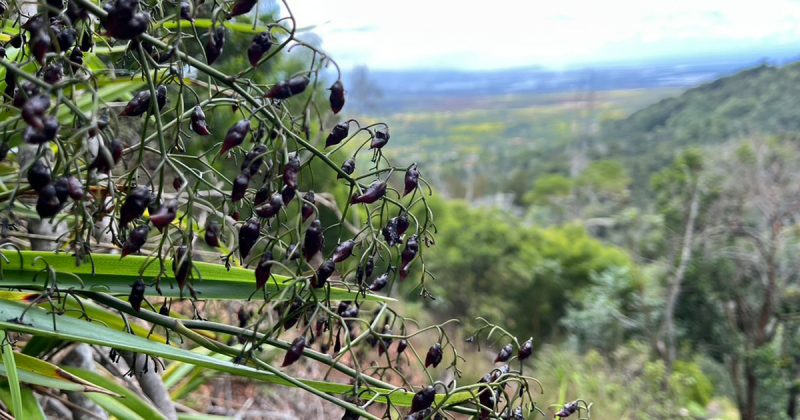
HTMC Talk Story #19
July 6, 2023
We did not have a Talk Story last month, so this month we have a Special Edition with Senior Day Care (SDC). They are a group of dedicated volunteers that meet Thursdays to care for a portion of the Honouliuli Forest Reserve with the permission and support of DLNR. Honouliuli is the largest ahupuaʻa on Oʻahu.
It’s a beautiful Thursday morning, and while turning into the Kunia Kiss & Ride, I see a handful of cars parked and their owners scattered about. People are putting on their hiking shoes, saying good morning to one another, and gathering around Ed’s trunk to take their share of some freshly picked bananas.
Ed is of course the famous Edwin Mersino, HTMC member since 2008. He has led many excursions for the Sierra Club and has used his well-loved pulaskis to build and maintain trails all over the island. But he is not the only famous one here. This group is a veritable who’s who in the conservation and hiking community.
Three of those celebrities are pictured here: Paul Meyer, Perry Barker, and Douglas “Dusty” Klein. Paul is a well-published photographer who recently presented at the clubhouse about circumnavigating the globe with Semester at Sea. Perry is a 2014 winner of the Hawaiʻi Invasive Species Council Award for his work leading SDC. Last but never least, Dusty recently received a recognition award from DLNR for his work trail clearing over the years. Perry will not be joining us up on the mountain today because he is recuperating. However, when I tell him of my plans to do an article about the group, he says, “That’s good. These folks don’t get anywhere near the recognition they deserve…not that they’re after that. But they do good work, and people should know that.” I agree.
After picking a bunch of bananas for myself (they were delicious), I ride with Ed, Carmel, and Minori to the agricultural/housing complex that fronts the reserve. Carmel is a hike coordinator with HTMC, and Minori hikes with the club and volunteers with organizations such as DLNR. When we get to our destination, Carmel realizes that she doesn’t have socks. True to good hiker form, three people offer her a makeshift sock/handkerchief, two pairs of large socks, and another pair that fits just right. Naturally, a discussion about people’s favorites follows. To summarize, Costco cotton is ok in a pinch, some Patagonia versions are awesome while others slip, Thorlo is great, and Darn Tough is a nice overall option. Gotta love gear talk.
When everyone is ready, we start walking. “We have an easement here,” remarks Ed as we circle around a property through tall grass, “but this is a new way.” Luckily, Darrell (another trail clearing awardee) cut some of this back last time with his hedge trimmer. Chicken coops line the left side of the path as we make our way to the trail that leads to the worksite. Along the way are plantings that need to be watered. There are old bleach, detergent, and water bottles strategically placed around the area. Sometimes new ones are brought in since you can’t count on there being enough rain here. It’s Ed and Paul’s jobs to read the gauges as we hike.
“Summer is especially hard,” Paul states, “because things can dry up quickly.” We’ll see a nicely growing kuluʻi and heavily flowering ʻiliʻeʻe lower down, but higher up Paul will notice an ʻilima. “See how the leaves are starting to curl up and dry out- and it’s only the start of the season.”
Luckily, there are some things they can do to help with the dry conditions. “Charlotte planted this maile here when it was really little,” Minori shares as she points to a thriving vine. Under the shade of an alaheʻe, it grew quickly. The area we are in has many plants doing well, but it also has many mosquitoes, so we walk farther up the hill. There we see another example of something that is as true in plant real estate as it is in houses: location, location, location. A healthy koa is growing next to an ʻukiʻuki, which helps to keep the available water in the root system instead of being lost in the loose dirt.
Finally, the area has a few water catchments. There is also a complicated system of pipes spread out all over the mountain. Though the catchments were brought in by helicopter, the piping was all installed by the volunteers. “These people are crazy,” Paul jokes, “They laid all these pipes across the valley and down the mountain on their own!” He should talk since he was one of the people walking on a steep mountainside with irrigation tubing in hand.
Soon it is time to stop admiring the work already done and do some work of our own. Besides watering, the main goal for today is to pull out as many weeds as possible, starting with ironwood. “We just came through here last week,” Ed laments as he bends down to pick up newly sprouted plants, “I can’t believe how many are popping up.”
Paul adds, “It’s like that movie The Neverending Story. The work just keeps going.” Still, we continue to go after them, along with grass and some herbaceous weeds. The work is made easier with my new hori hori garden knife. I ordered it after the last time I came here and Lynette let me borrow hers.
Lynette Williams is not here today, but she is a regular SDC participant. She was the one spraying everyone’s shoes with alcohol in the parking lot last time. She knows what to do because she used to work with the Nature Conservancy and has worked with many other organizations like the Army Natural Resources Program on Oʻahu (OANRP). After a while, the areas we weeded were clear of the unwanted plants…at least for now.
When Paul and I go up the switchbacks further to check on plants that need watering, he excitedly gestures towards one area and says, “Look at all these keiki coming up!” Sure enough, there are a bunch of little neleau spreading out around a larger plant. “We weren’t sure if this was just the roots spreading out, but it looks like these are individual plants.” It’s very cool to see, and there are koa and ʻilima plants spreading on their own as well.
Part of the reason this area was chosen for planting was because of a fire years ago. The group recalls at lunch time that it was 2010 when SDC first began working in the reserve. They started on Wiliwili ridge, the next ridge over from where we are now, doing all kinds of fun projects including native plantings, removing invasives like satin leaf, setting up miniature catchments, etc. Then the fire hit. Sandy, Dusty’s wife, tells how, “when we came over here that day, some of the logs were still smoldering. But the area was clear and we thought this would be a good place to work. So we cleared even more, and it turned out that all the ashes gave the ground nutrients.” Indeed, fire can increase soil fertility, organic carbon content, weathering, and soil formation. It was at that point that their efforts became more focused here.
As lunch continues, I ask some of the typical talk story questions such as what are peoples’ favorite hikes or outdoor experiences. Ed shares that his favorite stretch of trail is the area between Poamoho cabin and the summit of Schofield (Same here). Paul tells about his time in school doing research with a group in Kaupō Gap and all the good fun that went on there. But the overall conversation just seems to naturally veer towards the body. Paul warns, “This is the part of the day where we all talk about our various ailments.”
“We used to describe time using years. Now we use decades,“ Ed adds. “I saw a guy I thought I knew on Manana the other day, but I didn’t want to ask him what his name was. So I thought to myself, great, now I’m going to have to wake up in the middle of the night and go, ‘Oh, yeah, that was so and so’.” From memory lapses and thinning blood to replaced knees and doctor visits, it’s a time to commiserate with and console one another. I think it’s also one of the best parts of visiting with SDC folks.
It reminds me of an exchange from Golden Girls where a friend tells Sophia, “I have so many things wrong with me- arthritis, high blood pressure, angina, just to mention a few.”
Sophia replies, “Who doesn’t? You can’t get into a canasta game unless you have at least two debilitating diseases.”
But all joking aside, you can tell from these conversations how much these people care about each other as friends. They are not only taking good care of this preserve, but they are taking excellent care of one another. When someone is not here, they will check on plants for them, water their gardens, or just send a video saying hello. It’s nice to see.
After lunch, Ed, Paul, Don (Paul’s brother), and I trek over to Wiliwili Ridge to check on the trail and some of the plants there. “Man, you can really tell how much work was put into making this trail,” Don says. The path we are on was made long before SDC was working here and really is quite impressive. The trail could be in better shape, though, so Ed takes it upon himself to start cutting some of the overgrowth back while the rest of us go farther along to check on some native plants. When we reunite, it’s time to head out.
The views along the way are gorgeous. Pictured above are Ed and Paul admiring a wiliwili tree. There is also lots of evidence of work both past and present. Below is a sign on a water catchment down on the ridge and some of the grass that Charlotte has been working on controlling. Charlotte Yamane is one of the co-founders of SDC and has worked with many organizations such as the Oʻahu Invasive Species Council (OISC) and the Plant Extinction Prevention Program (PEPP). She was honored in 2015 as a Community Hero by the Hawaiʻi Invasive Species Council.
Before we know it, we are walking by the chickens again, through the grass, and out to the cars. People change out of their dirty shoes, Carmel returns the borrowed socks, and we all bid farewell to the forest for the day.
This is the view that was in my mind that day as I drove away from the Park and Ride and back into town. That and the memory of good people with good stories doing good work. If you would like to volunteer, feel free to learn how in the Volunteer section of the newsletter. They are always looking for new people, and anyone would be lucky to spend the day with them.

